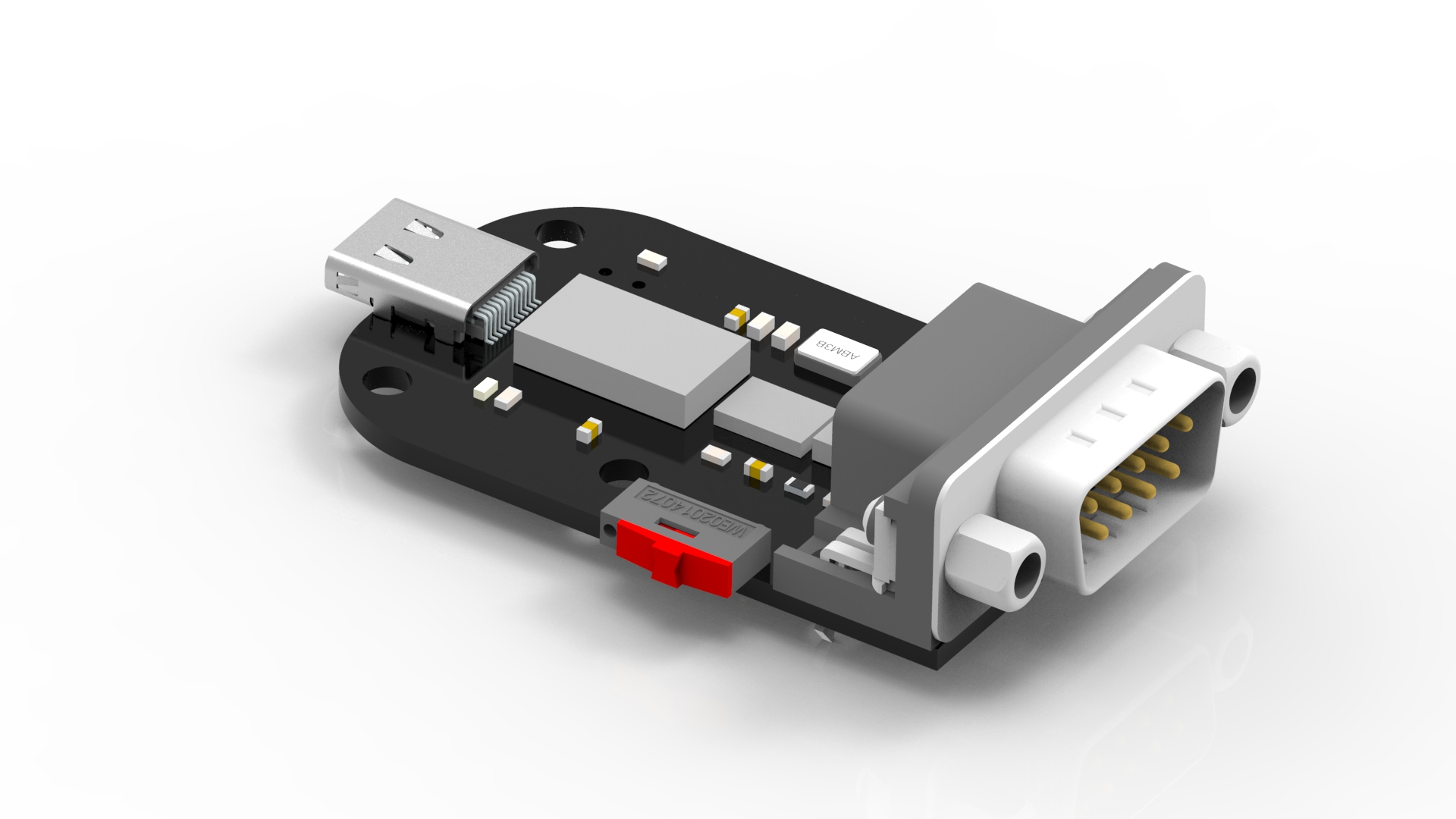 Rendering of
Rendering of usb-can, our version of the USBtin by Thomas Fischl
Be it for automation, development or debugging, one often needs a way to inspect a CAN bus. This device allows to connect to a CAN bus via a standard USB type C cable. It is based on the USBtin by Thomas Fischl - there are many great resources behind this link, and we encourage you to buy Thomas' version from him!
All examplatory output comes from a 2013 MacBook Pro running Debian.
Start by adding yourself to the dialout group if you aren't already in it:
» sudo usermod -aG dialout $USERYou'll need can-utils for Linux.
If you're on something Debian-based, you're best off installing them like so:
» sudo apt install can-utilsIf you're on a different distro, you may find the can-utils in your
respective package management; if not go get them from
GitHub. Good, now you're all set.
CAN support via socketcan is upstream in Linux, but it is not necessarily
loaded by default. Execute load like so:
» sudo modprobe can
» sudo modprobe can-raw
» sudo modprobe slcanYou can use the lsmod utility to verify everything has worked:
» lsmod | grep can
slcan 16384 0
can_raw 20480 0
can 24576 1 can_rawYou output may look slightly different, but you should see the modules loaded.
There are a number of ways to do this. First off, you may want to check that
the usb-can is actually recognized via lsusb (which you may have to
install):
» lsusb
...
Bus 002 Device 015: ID 04d8:000a Microchip Technology, Inc. CDC RS-232 Emulation Demo
...If the device shows up here, you can look which serial port it is bound to:
» sudo tail /var/log/kern.log
Apr 18 14:53:17 rzrgrl kernel: [64635.125815] usb 2-2: new full-speed USB device number 15 using xhci_hcd
Apr 18 14:53:17 rzrgrl kernel: [64635.276572] usb 2-2: New USB device found, idVendor=04d8, idProduct=000a, bcdDevice= 1.00
Apr 18 14:53:17 rzrgrl kernel: [64635.276580] usb 2-2: New USB device strings: Mfr=1, Product=2, SerialNumber=0
Apr 18 14:53:17 rzrgrl kernel: [64635.276583] usb 2-2: Product: USBtin
Apr 18 14:53:17 rzrgrl kernel: [64635.276585] usb 2-2: Manufacturer: Microchip Technology, Inc.
Apr 18 14:53:17 rzrgrl kernel: [64635.277670] cdc_acm 2-2:1.0: ttyACM0: USB ACM deviceIn this case, it is ttyACM0, which should be similar for you.
The following commands come from can-utils, so if you haven't installed those
so far, do that now.
Next, you should select the bus speed of the CAN you're trying to connect to. The available speeds are:
| Baudrate (kBaud) | Number encoding | Command paramete |
|---|---|---|
| 1.000 | 8 | -s8 |
| 800 | 7 | -s7 |
| 500 | 6 | -s6 |
| 250 | 5 | -s5 |
| 125 | 4 | -s4 |
| 100 | 3 | -s3 |
| 50 | 2 | -s2 |
| 20 | 1 | -s1 |
| 10 | 0 | -s0 |
Setting up a 500 kBaud CAN interface at serial port ttyACM0 is done like so:
» sudo slcan_attach -f -s6 -o /dev/ttyACM0
attached tty /dev/ttyACM0 to netdevice slcan0
» sudo slcand ttyACM0 slcan0
» sudo ip link set slcan0 upCongratulations, you've done it!
Now you can send and receive CAN messages on the socket interface slcan0. For
example, to dump all incoming messages to the terminal:
» candump slcan0The candump utility also allows you to filter for CAN IDs, set up the byte
order, and a number of other useful things it will tell you about if you as it
nicely (candump -h).
Sending a frame to CAN is similarly easy:
» cansend slcan0 7ff#deadbeefThe cansend utility is also very vocal about its capabilities if asked.
Further useful components of can-utils:
-
the
canplayerutility, which lets you play CAN messages from a log file that looks like this:(0.100) slcan0 5D1#0000 (0.200) slcan0 271#0100 (0.300) slcan0 289#72027000 (0.400) slcan0 401#081100000000The first column is a timestamp allowing for time controlled dumping of the frames, the second and third are (hopefully) self-explanatory by now.
-
the
canbusloadutility for analyzing the load on the bus.
Both utilities will also happily tell you about themselves with -h.
Last but not least, here is a snippet for sending the current time in the
format {hour}{minute} to the CAN on ID 0x7ff, i.e. the last and therefore
least priority ID, every 5 seconds:
while true
do
cansend slcan0 7ff#$(printf '%02x%02x' $(date +"%I") $(date +"%M"))
sleep 5
donePlease find hints for Windows on Thomas Fischl's website.
For macOS, there is code floating around the web for
socketcan and for
can-utils, and once you have
those working the above guide for Linux should mostly apply. No idea if it
works, though - we don't do macOS right now.
The contents of this repository which are our original work are released into the public domain unter The Unlicense (see LICENSE). We build heavily on the work of others here and recommend you pay them tribute first if you like the material you've found here.
- 1x usb-can_housing-lower (3d print)
- 1x usb-can_housing-lower-clean or -icon version (3d print)
- 4x Socket screw M3x8mm
- 4x Thread insert M3x4.78mm
- 1x usb-can PCB board